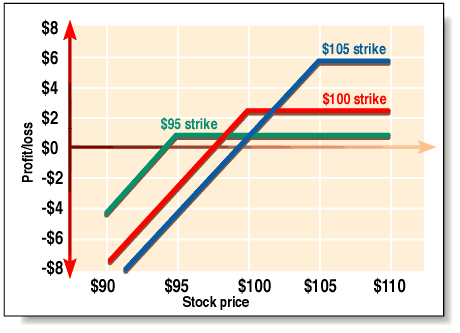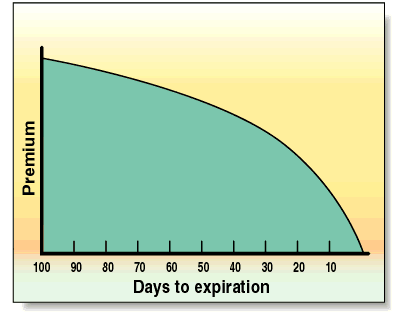
HOT TOPICS LIST
- Strategies
- Stocks
- Buy
- Investing
- Brokers
- Psychology
- Interviews
- Accumulate
- Sell
- Hold
- Spotlight
- Websites
- Candlestick Corner
- Gold & Metals
- Options Trading
LIST OF TOPICS
TRADER'S NOTEBOOK
Writing Covered Calls
12/18/01 03:11:52 PM PSTby Michael Dunham
If you think that options trading is only for short-term traders and speculators, think again.
| By taking advantage of an option strategy known as covered call writing (selling), you can gather small, consistent returns, which, when compounded over time, can give you a respectable overall return. Not only that, writing covered calls with a buy-and-hold strategy can protect your portfolio from major losses. Considering there are more than 2,000 stocks with listed options, as well as options on some depository receipts (MDY, QQQ, and so on), you have an array of choices.
BASICS OF CALL OPTIONSWhen you sell a call option, you are selling the right to buy the stock (referred to as exercising the option) at a given price (also known as the strike price) at or before a specific date (or the expiration date). The price of the option is known as the premium. The expiration date for stock options is the Saturday after the third Friday of the month. American-style options can be exercised on or before the expiration date, while European-style options can only be exercised on the expiration date. Since most stock options are American-style, this article will discuss them only. When you write a covered call, you are selling a call against stock you already own. So if the underlying stock rises above the strike price of the call you sold, you can provide the buyer of the option with stock you already own (should the buyer elect to exercise the call option). You could also opt not to own any of the underlying shares. This is referred to as a naked call and is much more dangerous, because you are exposed to potentially unlimited risk. In the options arena you often hear terms such as in-the-money/at-the-money/out-of/the-money. These refer to the relationship of the strike price to the stock price. A call is in-the-money when the strike price is less than the current price of the stock. An at-the-money call has a strike price that is the same as the stock price, and an out-of-the-money call has a strike price that is higher than the current price of the stock. For example, if a stock is trading at $30, a $25 call would be in-the-money, a $30 call would be at-the-money, and a $35 call would be out-of-the-money.
PREMIUM COMPONENTSAn option premium is made up of three components: the intrinsic component, the time component, and the volatility component. Whether you are buying or selling an option, it is important to understand how each of these three components affects the option premium. The intrinsic component is how far the strike price is in-the-money. For example, if a stock is trading at $35, a $30 call would have a $5 intrinsic value in the premium. The time component is related to the amount of time left until expiration. The more time is left until expiration, the greater the chance the stock will trade above the strike price and the more money a call buyer is willing to pay for the option. The volatility component is related to the volatility of the stock. If the stock is making large price moves, it is more likely to trade above the strike price of the option, and is more attractive to the option buyer. It is not uncommon for the price of a stock to go up and the premium of the option to go down because of changes in volatility.
WHAT STOCK TO SELECT?You should never buy a stock just because the options have high premiums. The stock must be researched before you buy. When writing a call, check the trading volume of the options on the stock being considered. Slippage on options — the difference between the bid price and the ask price — can be a large percentage of the premium on low-volume options. When all else is equal, it is better to select a stock with a higher option volume.
WHAT STRIKE PRICE TO SELECT?Strike prices are in $5 increments for stocks over $30 ($35, $40, $45. . .) and in $2.50 increments for stocks under $30 ($10, $12.50, $15. . .). Strike prices for depository receipts are in $1 increments. The strike price depends on your outlook for the underlying stock. If you are bullish on the stock, you can write an out-of-the-money call. The premium you will receive would not be as much as an at-the-money or in-the-money call (which limits your downside protection), but would allow you to pocket more of the price appreciation of the stock. If you are neutral on the stock, you could write an at-the-money or in-the-money call. The premium would be greater than an out-of-the-money call (which gives greater downside protection). Figure 1 displays the profit/loss for three different strike prices on a stock that is trading at $100 with 30 days left until expiration. Always consider you have to sell the stock at the strike price selected.
Figure 1: The profit/loss for three different stock prices. The stock is trading at $100, with 30 days left until expiration.
WHAT MONTH TO SELECT?The nearest month is usually the best. The decrease of the time component of the premium (called time decay) accelerates as it gets closer to expiration (see Figure 2). Selecting the nearest month also gives you the flexibility to make adjustments every month, if necessary, in your stock portfolio.
Figure 2: The time decay accelerates as the premium approaches expiration.
These adjustments include rolling — buying back the call that was sold and selling a new call with a higher strike price (rolling up), a lower strike price (rolling down), or a longer expiration (rolling out). You should consider rolling when 75% of the premium is gone. Once the premium of the option has decayed to this point, most of the downside protection is gone as well. Before rolling down or rolling out, reevaluate the stock to see if it should still be held. If analysis shows that the stock should be sold, sell it and establish a new covered call position with a different stock. Here are a few examples:
Example 1: Rolling Up
The example shows a $1.20 profit between rolling up and letting the call be exercised ($3.65-$2.45). Commissions and slippage for the additional two trades were ignored in the example. These would reduce the $1.20 profit. If a stock has made a big move up, it is best to allow the options to be exercised and the stock called away. When a stock makes a big move up, its volatility component increases. When added to the increased intrinsic component, that makes the option more expensive to buy back. In the previous example, the volatility did not increase. If it had, the premium of the $100 10-day call — the one you have to buy back — would have increased, which would reduce the $1.20 profit.
Example 2: Rolling Out As in Example 1, commissions and slippage for the additional two trades were ignored. With 10 days left on the $100 call, most of the premium has eroded. Rolling into the next month's call gives additional downside protection. Rolling out can be used in combination with rolling up or rolling down.
Example 3: Rolling Down Again, commissions, slippage, and volatility were ignored. It is important to remember that volatility increases on large moves up or down ultimately affect the volatility component.
UPS AND DOWNS OF COVERED CALLSMost calls expire worthless, which suggests that selling calls is more likely to be profitable than buying calls. When you write a covered call you gain additional downside protection, because the premium collected will offset some of the losses that may occur. Even if the stock doesn't go up in price, you can still make money. While the premium, when compared to the price of the stock, may seem small, when it is compounded monthly the annualized return can be large. So where can you go wrong? Covered call writing limits the amount of upside potential you can get from a big move in the stock. There is nothing more frustrating than to watch a stock you own be the target of a takeover and jump from $17 to $27 in one day, knowing that you wrote a $17.50 call against that stock.
SUMMARYThe monthly compounding of profits is the key to this strategy. Then, of course, there's the hedging advantage. Before investing in options, be aware of how the three premium components affect the price, and don't forget to consider commissions and slippage when planning a trade.
Michael Dunham is a mechanical engineer. He can be reached at mdd@rimpull.com.
REFERENCESBittman, James B. [1997]. Options For The Stock Investor, McGraw-Hill.Chicago Board of Options Exchange (CBOE), www.cboe.com/learncenter Demkovich, Joe, and Eugene Theriot [1999]. "Getting Started With Options," Technical Analysis of STOCKS & COMMODITIES, Volume 17: October. _____ [2000]. "Increasing Returns With Covered Calls," Technical Analysis of STOCKS & COMMODITIES, Volume 18: January. Lyons, Alan S. [1994]. Winning In The Options Market. Chicago: Irwin. McMillan, Lawrence G. [1993]. Options As A Strategic Investment, New York Institute of Finance. Options Industry Council, www.888options.com
Current and past articles from Working Money, The Investors' Magazine, can be found at Working-Money.com. |
| E-mail address: | mdd@rimpull.com |
PRINT THIS ARTICLE

|

Request Information From Our Sponsors
- StockCharts.com, Inc.
- Candle Patterns
- Candlestick Charting Explained
- Intermarket Technical Analysis
- John Murphy on Chart Analysis
- John Murphy's Chart Pattern Recognition
- John Murphy's Market Message
- MurphyExplainsMarketAnalysis-Intermarket Analysis
- MurphyExplainsMarketAnalysis-Visual Analysis
- StockCharts.com
- Technical Analysis of the Financial Markets
- The Visual Investor
- VectorVest, Inc.
- Executive Premier Workshop
- One-Day Options Course
- OptionsPro
- Retirement Income Workshop
- Sure-Fire Trading Systems (VectorVest, Inc.)
- Trading as a Business Workshop
- VectorVest 7 EOD
- VectorVest 7 RealTime/IntraDay
- VectorVest AutoTester
- VectorVest Educational Services
- VectorVest OnLine
- VectorVest Options Analyzer
- VectorVest ProGraphics v6.0
- VectorVest ProTrader 7
- VectorVest RealTime Derby Tool
- VectorVest Simulator
- VectorVest Variator
- VectorVest Watchdog


